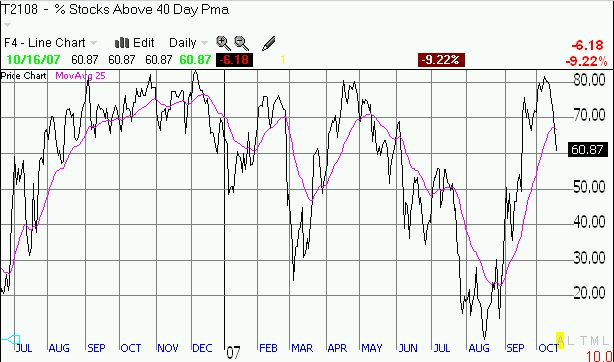After the Fed cut rates on September 18th by an astounding 50 basis points to 4.75%, the 10-year treasury bond closed the day at 4.48%. The 10-year spiked over the next two days another 19 basis points to 4.67%, and it has bounced around this level over the past week. The Fed claimed that it acted in such a drastic manner to help prevent tightening credit conditions from accelerating the weakening of the housing market. This action would then help insulate the economy from these same problems.
Now, a month later, the homebuilder stocks are weaker than ever and financials have repeated the post-Fed fade that I reported last month. The XHB, the homebuilders ETF, is scraping at 52-week lows again and is 13.5% below the close on Sept 18th. The XLF is essentially at the same price it held right before the Fed announcement. The regional banks, as represented by RKH, are now below the first post-Fed fade. Finally, the retail sector continues to lag with lady's apparel taking some of the hardest hits these days (Nordstrom (JWN) isthe latest such disaster). Accordingly, the RTH, the retailers ETF, still has not recovered from its post-Fed fade and is back below the price of the open on Spet 18th. Note that I made no reference to economic data. I constantly hear that it takes anywhere from 6 to 12 months for a change in Fed action to be felt in the economy. If true, current economic data is much less relevant than the market's attempt to price in what future economic data might look like. So far, the market is giving the Fed a vote of no-confidence in fixing the problems it said it set out to fix. Moreover, the slightly higher rates in the 10-year are serving as a direct counter-measure against the Fed ease and hurting, not helping, homebuilders and banks.
The bump up in rates is too small to say it represents a market that is taking inflation more seriously than the Fed. Sure the dollar index is reach back to 15-year lows and gold is at multi-decade highs. Oil is incredibly scratching at $88/barrel. Remember how folks laughed and derided Goldman Sachs analysts Arjun Murti and Brian Singer when they predicted $100 oil back in March 2005? Heck, remember when invading Iraq was supposed to secure cheap oil for us for years to come? Anyway, this time around we can thank our lucky stars that gas prices have been stuck in neutral - much to the chagrin of refiners I am sure. But somehow the government keeps spinning out benign inflation numbers. I do not pretend to understand how inflation remains contained, but enough people believe it right now to keep interest rates from spiking further.
So, on the other side of the market we have sectors cruising right along on the Fed's goodwill and robust global demand. The energy and commodity sectors continue to rip of course, but tech has become the true darling. The 14.5% rise in the NASDAQ this year will have you doubting whether there was really any financial problem this year. Intel's strong earnings report last night will remind you of the strength of the global growth engine. It will have all the bears pulling out more hairs as they continue to wait for chip demand to collapse and then take the entire technology sector down in short order.
It seems only fitting that after the consumer propped up the economy during the short recession of 2001/2002 by speculating on homes and filling them with electronics or otherwise drawing down equity, it is now corporate's turn to rush to the rescue. All signs continue to point to a weak or weaker domestic economy while those who make money overseas will continue to do well. I would love to find out whether there have been similar times of such strong divergence in the U.S. financial markets. Something about this set-up just does not seem sustainable to me. It seems to me at some point soon the U.S. consumer will have to perk up again to keep the overall stock market going. Perhaps the foreign currency that crosses our borders to take advantage of the relative deals and steals will eventually find its way into the U.S. consumers' collective pockets and not just corporate coffers. Should be interesting to say the least.
One final note. A T2108 check. I neglected to point out last week that this indicator of the percentage of NYSE stocks that are above the 40 DMA was signalling a red alert. When T2108 gets into the 70-80% range, the market is getting stretched. And when it hits 80% and above, some kind of correction is almost a lock. We went above 80% on Oct 5th and hung there on Oct 8th. The S&P 500 churned for a few more days before hitting a new intra-day, multi-year high and then whipping out the current small correction. As long as earnings come in OK (like last night), I cannot imagine the selling extending too deeply. Already, T2108 has quickly dipped back to 61%, so we have room to grow again. And I definitely think that August's lows were a capitualtion bottom and a successful test of the year's low back in March. I am looking forward to a strong run to close out the year, at least after these next two weeks or so of earnings.

Note how fast T2108 snapped back up from those treacherous lows in August. The "rest" and pullback in the past week should come as no surprise!
Be careful out there!
.468w60h.jpg)